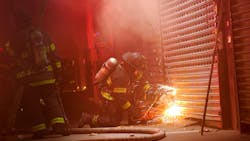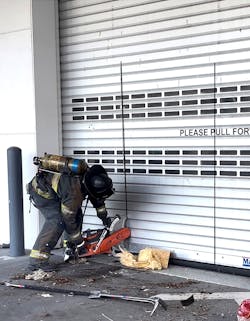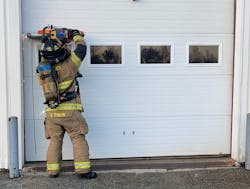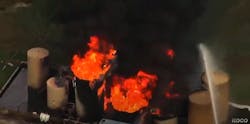Forcible Entry: Roll-Down Gates & Garage Doors
Commercial occupancies undoubtedly give us a run for our money on the fireground. This primarily is because of business owners adding locking devices to prevent theft or unwanted entry into their structures. Depending on the city or town, you can find a high percentage of commercial businesses covered with steel roll-down gates; other commercial occupancies might have an abundance of folding panel garage doors or a wide variation of garage door types.
Although it isn’t common to find roll-down gates on residential houses, garage doors are, of course, found on both residential structures and commercial buildings. It’s important that you be familiar with the tactics for making entry into these bigger doors on the fireground.
It’s rather safe to say that the main reason for making access through garage doors on the fireground is to make access into the structure for line advancement to the seat of a fire or to carry out the process of smoke, fire or heat removal. Regardless of the reason, the fact is that bigger doors require members to make bigger openings, and this only can be done with good saw fundamentals and a great understanding of where and how to cut.
Steel roll-down gates
Steel security roll-down gates are found commonly in urban areas and mainly on commercial buildings. There are three main types of gates/how they operate: manually operated with no chain, manually operated with a chain and electrically operated types that have a secured key box on the exterior of the structure and use a button or another key to operate the gate.
When dealing with steel roll-down gates, you must evaluate your options as to what’s the simplest means to get in based on fire conditions presenting on the gate. When it comes to manually operated gates, a lot of times, you usually will cut the lock and raise the gate by hand or the chain. On electrically operated gates, if possible, you should attempt to raise the gate via the outside key box or interior button. There are times when you might need to cut the gate because of fire conditions or mechanical problems. When you do come to that point, the best cut for roll-down gates is the slash cut technique.Below is the series of steps that you want to take when making the slash cut:
- Purchase points must be made by driving the pick of a Halligan into the slats above the locking pins. This is done before cuts are made. It allows for easy removal of slats after cuts are made.
- As far left or right as possible on the gate, start by cutting one vertical cut from as high as the saw handler can reach, straight down to the bottom rail.
- Make one vertical cut in the center of the gate that encompasses cutting roughly four slats to include where the purchase point was made.
- The last cut is as far left or right (opposite the first cut) as possible. This cut also is as high as the saw handler can reach, straight down to the bottom of the rail. In total, three cuts are made: two long cuts on both sides of the gate and one short cut in the center.
- Insert a Halligan in the purchase points. The slats can be removed toward the center cut. The remaining slats will go upward into the gate, and the lower slats will pull out of the track.
Garage doors
Over the years, the fire service has seen many different “style” cuts on garage doors. Often when evaluating cuts, people tend to look at the following items as key factors in deciding which tactical cut they want to use:
- What’s a fast style cut to make?
- What tactical cut requires the least number of cuts on the door?
- What tactical cut provides the biggest opening on the door for the operation?
All three questions are fair questions and ones that anybody who is trying to help a fireground operation should consider if that person wants to be effective to the fireground.
That said, one of the best cuts to evaluate that will give you a mix of all three of the items that are noted above is the box cut. It probably has been the leading cut in the fire service for many years for entry tactics on both commercial and residential garage doors. Its name derives from the result of the cut sequence: a garage door opening that resembles a huge square—basically, a box.
The box cut requires three simple cuts, all of which are straight lines that are made at a reasonable height of the operator.The first cut in the series is the first vertical cut. It’s best placed to the far side of the garage door (either right or left side). The cut is at a high point that’s safe for the saw handler to operate the saw. The saw is plunged deeply into the door’s panels and straight down to the street/sidewalk or driveway. If staffing allows it, have a member spike a hole in the panels with the pick of a Halligan. This can provide a place for members to pull when the series of cuts are complete.
The second cut overlaps the first cut and is run horizontally across the width of the door. This cut also requires the saw to be plunged into the garage door panels and the saw handler to operate the saw above head-height. It’s vital that the saw handler is comfortable operating the saw while having it raised at the height.
The third cut overlaps the second cut on the opposite far side of the garage door. This cut also goes vertically down to the street/sidewalk or driveway.
As the third cut is being completed, be cognizant of the fact that you just cut a complete square hole in the garage door. Naturally, the weight of the door will make the cut section want to drop inward or outward from the remaining door. This is where it’s good to be able to use a Halligan or a hook to pull the cut garage door section out toward the exterior of the structure. (Note: Some people make a fourth, diagonal cut from the far side down to the street/sidewalk or driveway. This cut gives members another place to pull the panels from).
Preplanning
The slash cut for steel roll-down gates and the box cut for folding panel garage doors are tactical considerations. The American fire service has many different tactics for cutting gates and garage doors. Regardless, saw handlers must ensure that they pick a tactic that allows personnel to get into the structure quickly, that requires the least amount of struggle for themselves, and that minimizes the amount of material from the gate or garage door that can get in the way of firefighters who will enter and exit the structure and/or snag/puncture a hoseline.
Get out into your first due area to check out challenges that you might encounter and start to develop the conversation of game day tactics with your crews.
Robert “RJ” James and Charles Hendry will present “Down & Dirty Urban Forcible Entry” at Firehouse.com. They will lead a HOT class of the same name, too. To register, visit firehouseexpo.com.
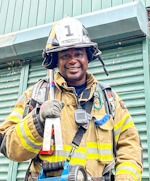
Robert "RJ" James
Robert “RJ” James is a 22-year veteran of the fire service. He started as a volunteer firefighter with the Cromwell, CT, Volunteer Fire Department. After that, James joined the Rockville Volunteer Fire Department in Montgomery County, MD. He currently is a career lieutenant in Special Operations Command assigned to the 3rd Battalion with the Frederick County, MD, Fire Department. James served as a lead instructor for many fire department trainings and works as an instructor, including with Capitol Fire Training. He has received numerous citations and awards. James has written articles for numerous magazines and has taught on national fire service platforms.

Charles Hendry
Charles Hendry has more than 33 years of experience in the fire service. He is a lieutenant in the FDNY Special Operations Command assigned to Squad 252, chief of training for the Hempstead, NY, Fire Department and a 33-year member of Harper Hook & Ladder Company 1. Hendry is a New York State Fire Instructor 2 and a deputy chief instructor at the Nassau County Fire Service Academy and the FDNY Technical Rescue School.
